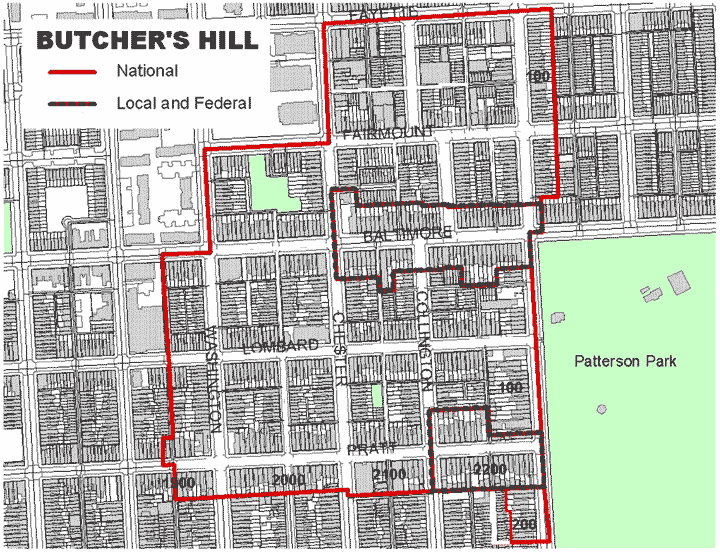Butcher's Hill
National Register of Historic Places 12/28/82
Certified Historic District for Tax incentives (NR)
Description
 The Butchers Hill Historic District is an irregular shaped area roughly bounded by East Fayette Street on the south, Patterson Park Avenue on the east, East Pratt Street on the south, and South Chapel, North Washington, and North Chester Streets on the west. An overwhelmingly residential neighborhood densely built with brick rowhouses at the crest of Hempstead Hill, Butchers Hill is an architecturally and historically distinct pocket of development in the regular grid of East Baltimore streets.
The Butchers Hill Historic District is an irregular shaped area roughly bounded by East Fayette Street on the south, Patterson Park Avenue on the east, East Pratt Street on the south, and South Chapel, North Washington, and North Chester Streets on the west. An overwhelmingly residential neighborhood densely built with brick rowhouses at the crest of Hempstead Hill, Butchers Hill is an architecturally and historically distinct pocket of development in the regular grid of East Baltimore streets.
The unique combination of dates of construction (1850-1915), sizes, and styles of buildings, with a hilly topography and peculiar pattern of development, as well as a generally high degree of integrity which is being enhanced by rehabilitation, sets Butchers Hill apart from the surrounding rowhouse communities. The district contains approximately 1000 buildings, northwestern corner of Patterson Park, the District's streetscapes afford exceptional views of Baltimore's harbor to the south, and downtown Baltimore to the west.
Significance
The various roles Butchers Hill has played in the historical development of East Baltimore and the greater Baltimore region, as well as the economic and ethnic groups it has hosted, are reflected in its buildings. Unlike most Baltimore neighborhoods which grew as contiguous expansions to older, harbor-dependent settlements, as individual water mill or stream villages, or as crossroads trading centers, Butchers Hill was settled and existed as a physically isolated, prosperous tradesman's village before the Civil War, Its subsequent engulfment by an expanding city began slowly in the 1850's accelerated in the 1870's and was completed by 1915. The community's associations with Williams Patterson and his heirs, the predominantly German merchants and industrialists, and the Jewish professionals and tradesmen who contributed to the growth of 19th and early 20th century Baltimore, and who successively populated and left Butchers Hill, can be clearly read in its extant resources.
The collection of buildings represents a fine cross section of late 19th century rowhouses styles, and belies the uniformity assumed to be inherent in rowhouse communities. The buildings of Butchers Hill are a significant and distinguished entity linked by topography, a unique development pattern and their integrity, as well as though the frequent use of elaborate iron work for structural and decorative purposes. The resources of the community have and will continue to yield information on the 19th century construction practices and patterns of growth, or communities.